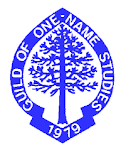Wouldn't it be nice to be able to say that we were descended from Sir Robert de Sadyngton, Lord High Chancellor of England in the reign of King Edward III?
Sorry, folks, but it isn't going to happen! Although I am led to believe that some Saddington researchers in the past have tried to claim descent from Sir Robert, it isn't true, so this post is a cautionary tale, which you can pass on to anyone who tries to tell you otherwise.
Sir Robert de Sadyngton probably did come from Saddington in Leicestershire, and is believed to be a son of John de Sadyngton, who was a valet of Queen Isabella, wife of Edward II, and custos (principal justice of the peace) for the Hundred of Gartree, an administrative area of Leicestershire, which includes places such as Billesdon, Foxton, Laughton, Market Harborough and Saddington.
Robert was a professional lawyer, who was listed in the records as an attorney as early as 1317, and appeared as an advocate in the year-books from 1329 to 1336. He was a Knight of the Shire (Member of Parliament) for Leicestershire in 1327 and 1328. He sat on various Royal commissions and fulfilled a number of judicial roles from 1329 onwards.
He was knighted in 1336, and on 20 May 1337, Sir Robert was appointed Chief Baron of the Exchequer, which meant that he was the top judge in the common-law court of the Exchequer of Pleas. He became a member of the King's Council in 1340, and on 29 September 1343, he was appointed Lord High Chancellor of England, a post which he held for just over two years, until 20 October 1345. He became Chief Baron of the Exchequer again on 8 December 1345, and held that office until 1 February 1349, when he was effectively permitted to retire, having "served the king long time and without intermission".
Despite retiring from the King's service, Sir Robert remained a Justice of the Peace for Leicestershire until at least 1357. The last record of him is on 25 April 1361, when he was the principal witness to a charter relating to Noseley chantry college.
So that is who he was and what he did out of the way. Now comes the important bit for Saddington researchers. Robert de Sadyngton married Joyce de Martivall, possibly a sister or a niece of Roger de Martivall, Bishop of Salisbury, in or around 1334. Robert's daughter and sole heir, Isabell, married Sir Rafe (or Ralph) Hastings in or around 1352. On her father's death, she inherited lands at Saddington, Laughton, Humberstone, Gilmorton, Scraptoft and Noseley. However, it appears that she did not have any children, and died before 1385. Her lands went to her husband, and passed down to the children of his second marriage to Maud Sutton, daughter of Sir Thomas Sutton of Holderness, High Sheriff of Yorkshire.
And there we go! Sir Robert de Sadyngton had one daughter, Isabell, who died without issue. This means that nobody by the name of Saddington or who is descended from a Saddington can claim to be descended from Sir Robert! And if anyone tells you otherwise, then they are wrong.
Sources for this post include: Oxford Dictionary of National Biography; "The Itinerary of John Leland the Antiquary" (pub. 1745, OUP) ; "A Political Index to the Histories of Great Britain and Ireland" by Robert Beatson (pub. 1806);"A Topographical History of the County of Leicester" by John Curtis (pub. 1831); "The Origins of the English Gentry" by Peter R Coss (pub. 2003)
Subscribe to:
Post Comments (Atom)

No comments:
Post a Comment